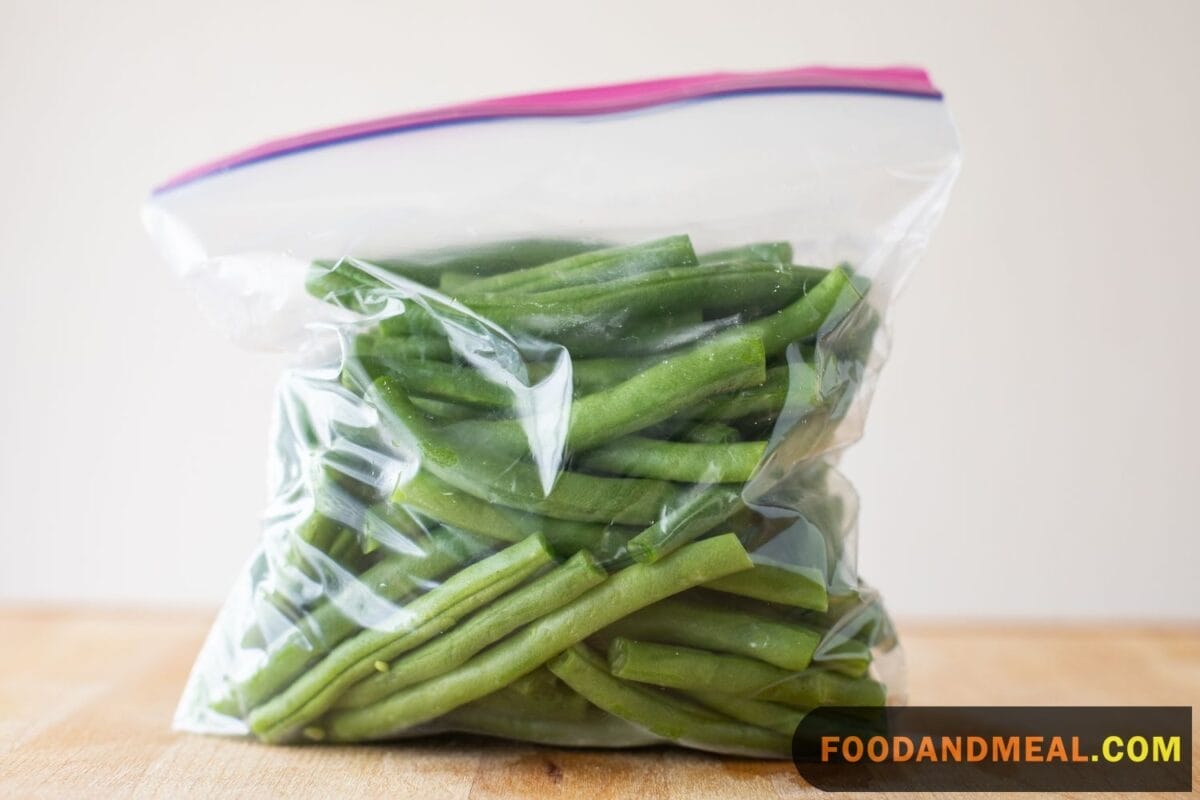Our fondness for green beans is not up for debate. Do not inquire as to why our pantry is perpetually stocked with them. We will trumpet the merits of green beans indefinitely, for they are one of the rare vegetables we can stomach due to our intricate digestive issues. Food and Meal will spare you the details of years navigating produce dictated by our condition, but green beans are certainly among the chosen few greens we rely on.
Thus, we champion string beans tirelessly, yet even we require respite at times, only to rediscover them forgotten in our refrigerator as a last resort. Such is our fate as someone limited to specific veggies, we suppose. Nevertheless, this predicament put us in an opportune position – we needed to master prolonging green beans while maintaining quality, both for personal use and professional purposes! We eagerly embraced the challenge of using our summer produce delivery to determine the best preservation methods. And so our journey began to uncover techniques for storing green beans that retain their freshness and flavor that we love so much.
The crisp, snappy texture of fresh green beans is so satisfying to bite into. We get excited to include them in our favorite summer recipes, like green bean salad with a tangy dressing. When fall and winter come around, opening a jar of our home-preserved beans transports us right back to summer. The bright green color and crunch reminds us of the joy of cooking with seasonal produce. We feel proud and accomplished when we serve our homemade preserved beans, knowing the hard work we put into storing them properly. Green beans really feel like a year-round staple meal thanks to the preserving skills we’ve developed together.
How long can green beans be used?
Prior to this experiment, we had never contemplated storing green beans in any way other than placing them directly in the refrigerator after purchasing them fresh from the farmer’s market or grocery store. This method had served us reasonably well, apart from the occasional shriveled bean. However, why settle for lackluster beans when it’s possible to maintain their crispness even longer?

As research from the 1980s shows, keeping green beans in a controlled atmosphere of 4°C to 8°C (39°F to 46°F) optimally prolongs their shelf life post-harvest, potentially extending it by 7-10 days. The lower end of this range aligns with most home refrigerators’ maximum temperature.
Studies also emphasize the necessity of high humidity for preserving string beans. Considering our refrigerator maintains 1°C to 4°C (34°F to 39°F), we recognized managing temperature and humidity would be key factors to experiment with during our trials. Before this, we had never explored methods beyond refrigerating beans straight from the source. But with proper conditions, we found we could prolong their peak freshness.
Testing Temperature
Considering this was a homemade experiment within our kitchen’s limitations, we acknowledged room temperature would be standard, while refrigeration tests would be confined to our fridge’s settings. We procured various green beans – loose whole ones from store bins, and pre-trimmed alongside whole.
Unaware of the precise temperatures during their journey from field to store, we refrained from brandishing a thermometer in the produce section. Instead, we swiftly brought home all the green beans, removed any visibly spoiled ones, mixed them into even batches, and focused on observing the impact of fridge versus room temperature.
By day two, we noted limp, slightly browned beans left at room temperature, both washed and unwashed. Meanwhile, every refrigerated batch showed no visible changes. This aligns with research showing bacteria thrives at room temperature, making deterioration unsurprising. For comparison, washed batches in the crisper showed similar signs starting day four.
In summary, our homemade tests within our kitchen’s confines highlighted the importance of refrigeration and limiting bacterial exposure for prolonging freshness of green beans. While not a controlled scientific study, it allowed us to apply research-backed principles using materials readily available in our home.

Testing Humidity Levels
Our fondness for green beans is not up for debate. Do not inquire as to why our pantry is perpetually stocked with them. We will trumpet the merits of green beans indefinitely, for they are one of the rare vegetables we can stomach due to our intricate digestive issues. We will spare you the details of years navigating produce dictated by our condition, but green beans are certainly among the chosen few greens we rely on.
Thus, we champion string beans tirelessly, yet even we require respite at times, only to rediscover them forgotten in our refrigerator as a last resort. Such is our fate as someone limited to specific veggies, we suppose. Nevertheless, this predicament put us in an opportune position – we needed to master prolonging green beans while maintaining quality, both for personal use and professional purposes! We eagerly embraced the challenge of using our summer produce delivery to determine the best preservation methods. And so our journey began to uncover techniques for storing green beans that retain their freshness and flavor that we love so much.
The crisp, snappy texture of fresh green beans is so satisfying to bite into. We get excited to include them in our favorite summer recipes, like green bean salad with a tangy dressing. When fall and winter come around, opening a jar of our home-preserved beans transports us right back to summer. The bright green color and crunch reminds us of the joy of cooking with seasonal produce. We feel proud and accomplished when we serve our homemade preserved beans, knowing the hard work we put into storing them properly. Green beans really feel like a year-round staple meal thanks to the preserving skills we’ve developed together.
Is Washing Green Beans Ever a Good Idea?
Certainly, cleaning green beans is a vital step, especially if they are destined for consumption. There’s no harm in washing them in advance if they’re to be eaten immediately. Unlike some perishable fruits like strawberries, green beans are less prone to rapid spoilage due to their thicker skin, which makes them more resistant to potential mold spores. The prevalent advice for storing string beans underscores not washing them before storage and keeping them whole in the refrigerator. However, at Food And Meal, we noticed an ambiguity surrounding how washing green beans affects their shelf life, prompting us to conduct our own investigation.
We cleaned several batches of green beans in room-temperature (78°F) water and hot (120°F) tap water, leaving one batch unwashed as a control group. For the washed batches, we meticulously dried some while leaving others with residual water droplets. These batches were then stored under various conditions: sealed plastic bags, open trays exposed to air, and standing in open deli containers, both inside the vegetable crisper and on a refrigerator shelf. Additionally, we tested some batches wrapped in slightly damp paper towels and some without. In total, we examined 16 different storage conditions for green beans.

Early in the experiment, it became evident that any added moisture, whether from residual washing water or damp paper towels, was as harmful to the beans as leaving them unprotected in the humidity of our kitchen during particularly humid days, especially in the summer.
By day two, almost all the green beans that had been exposed to water, regardless of the drying process or storage method, began showing initial signs of decay, such as puckering, slight browning, and wilting. Although these could still be used until the fourth day, the batches treated with cold water, particularly those in the crisper, were significantly puckered by then.
Unwashed beans in the crisper performed better between days six and eight, but those stored outside the drawer consistently appeared healthier throughout the experiment. It became clear that washing the beans and storing them in the vegetable drawer introduced excess humidity, which was not beneficial.
Interestingly, the only batch of beans that preserved their appearance until day seven were the unwashed ones placed on a middle refrigerator shelf. However, by day eight, these unwashed beans, tightly sealed and stored on the refrigerator shelf, began to show signs of browning. While it’s unclear what specifically caused this decline, it may be that the sealed container trapped excess moisture released by the beans over time, forming unwanted condensation that expedited spoilage.
On day ten, the final batch—unwashed beans exposed to airflow on the refrigerator shelf—started to wrinkle but maintained their bright green color and overall quality reasonably well. On day 11, we consumed this batch, trimming the ends and cooking them as usual. We didn’t notice any significant difference in flavor compared to the beans we had eaten much earlier.
Step-by-Step to Extending the Shelf Life of Green Beans
In brief: Prior to refrigeration, avoid washing the green beans and store them wholly intact. Should you contemplate purchasing pre-trimmed beans or opt for trimming them yourself, our editors have previously covered this topic and hold strong opinions on both approaches. Regardless, here’s what you should follow:
1. Whenever feasible, purchase untrimmed beans.
2. Discard any individual beans that exhibit signs of browning or rot.
3. Arrange the beans directly on a tray lined with paper towels or position them upright in an open deli container.
4. Store the beans in the refrigerator.
5. Wash and trim the beans immediately before consumption.
FAQs About How to Store Green Beans
- Q: How should I store fresh green beans to maintain their freshness? A: To maintain the freshness of green beans, store them unwashed in a perforated plastic bag or a loosely closed plastic bag in the refrigerator’s crisper drawer.
- Q: Can I store green beans at room temperature? Green beans are best stored in the refrigerator. However, if you plan to consume them within a day or two, leaving them at room temperature is acceptable. Keep them in a cool, dark place and use promptly.
- Q: How long can I store fresh green beans in the refrigerator? Fresh green beans can be stored in the refrigerator for about 7 to 10 days. It’s advisable to check them periodically for freshness and use them before they start showing signs of wilting or discoloration.
- Q: Should I wash green beans before storing them? It’s recommended to store green beans unwashed. Washing them before storing can introduce moisture, which may lead to mold growth. Wash the beans just before preparing or consuming them.
- Q: Can I freeze green beans for long-term storage? Yes, green beans can be frozen for long-term storage. Blanch them in boiling water for a few minutes, cool them quickly in an ice bath, drain, and then freeze them in airtight containers or freezer bags.
- Q: How should I prepare green beans for freezing? To prepare green beans for freezing, trim the ends, cut them into desired lengths, and blanch in boiling water for 2-3 minutes. After blanching, cool them in an ice bath, drain thoroughly, and pack for freezing.
- Q: Can I store green beans with other fruits and vegetables? Green beans are sensitive to ethylene, a natural gas produced by some fruits and vegetables that can accelerate ripening. Store green beans away from ethylene-producing fruits like apples and tomatoes to prevent them from overripening.
- Q: Can I store cooked green beans differently from raw ones? Yes, cooked green beans should be stored in an airtight container in the refrigerator. Use them within 3-4 days. For longer storage, consider freezing cooked green beans following the same blanching and freezing process as raw ones.
- Q: How can I tell if green beans are no longer fresh? Signs of aging or spoilage in green beans include wilting, discoloration, and the development of a slimy texture. Inspect the beans regularly and discard any that show these signs.
- Q: Should I store green beans in a crisper drawer or on a shelf in the refrigerator? Storing green beans in the crisper drawer helps maintain proper humidity levels and prevents them from drying out. If your refrigerator doesn’t have a crisper drawer, store them in a perforated plastic bag on a refrigerator shelf.
- Q: Can I store green beans in a vacuum-sealed bag? Vacuum-sealing green beans can help extend their freshness by removing air and reducing the risk of freezer burn if freezing. However, for short-term storage in the refrigerator, a perforated plastic bag is usually sufficient.
I'm Kelly Atkinson, with a passion for dissecting the world of home goods. My reviews stem from thorough testing and a love for sharing detailed insights. Each piece I write offers a glimpse into my explorative journey, aiming to guide readers to informed choices with authenticity and precision, making every review a blend of exploration and expertise.
